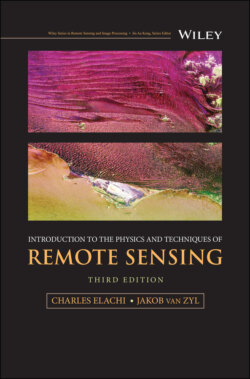Читать книгу Introduction to the Physics and Techniques of Remote Sensing - Jakob J. van Zyl - Страница 32
2.4 Detection of Electromagnetic Radiation
ОглавлениеThe radiation emitted, reflected, or scattered from a body generates a radiant flux density in the surrounding space which contains information about the body properties. To measure the properties of this radiation, a collector is used, followed by a detector.
The collector is a collecting aperture which intercepts part of the radiated field. In microwave, an antenna is used to intercept some of the electromagnetic energy. Examples of antennas include dipoles, an array of dipoles, or dishes. In the case of dipoles, the surrounding field generates a current in the dipole with an intensity proportional to the field intensity and a frequency equal to the field frequency. In the case of a dish, the energy collected is usually focused onto a limited area where the detector (or waveguide connected to the detector) is located.
In the IR, visible, and UV regions, the collector is usually a lens or a reflecting surface which focuses the intercepted energy onto the detector. Detection then occurs by transforming the electromagnetic energy into another form of energy such as heat, electric current, or state change.
Depending on the type of the sensor, different properties of the field are measured. In the case of synthetic aperture imaging radars, the amplitude, polarization, frequency, and phase of the fields are measured at successive locations along the flight line. In the case of optical spectrometers, the energy of the field at a specific location is measured as a function of wavelength. In the case of radiometers, the main parameter of interest is the total radiant energy flux. In the case of polarimeters, the energy flux at different polarizations of the wave vector is measured.
In the case of x‐ray and gamma‐ray detection, the detector itself is usually the collecting aperture. As the particles interact with the detector material, ionization occurs, leading to light emission or charge release. Detection of the emitted light or generated current gives a measurement of the incident energy flux.
